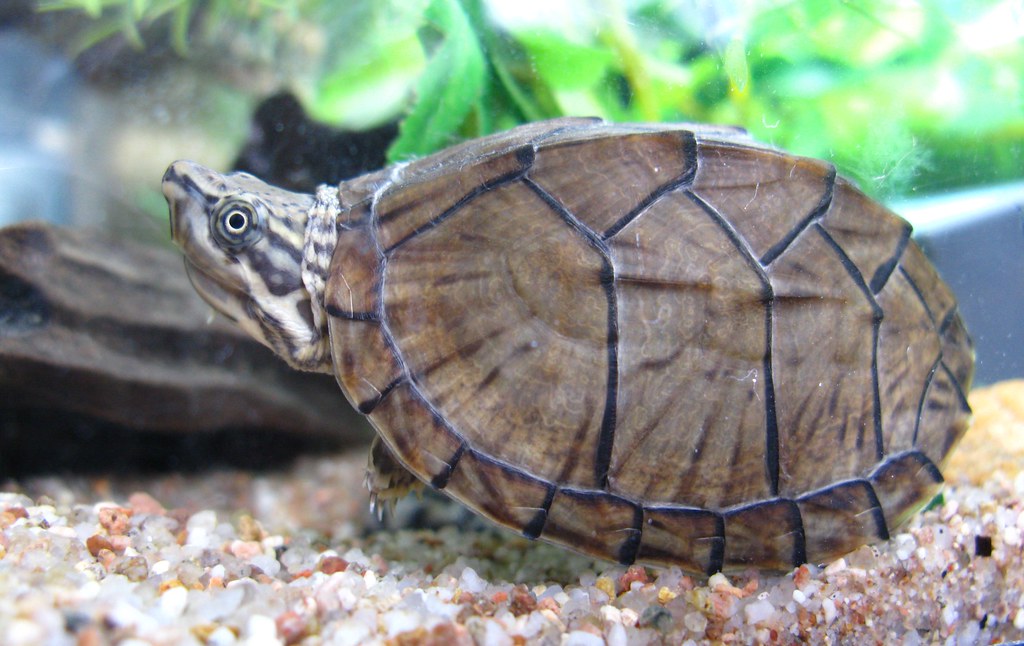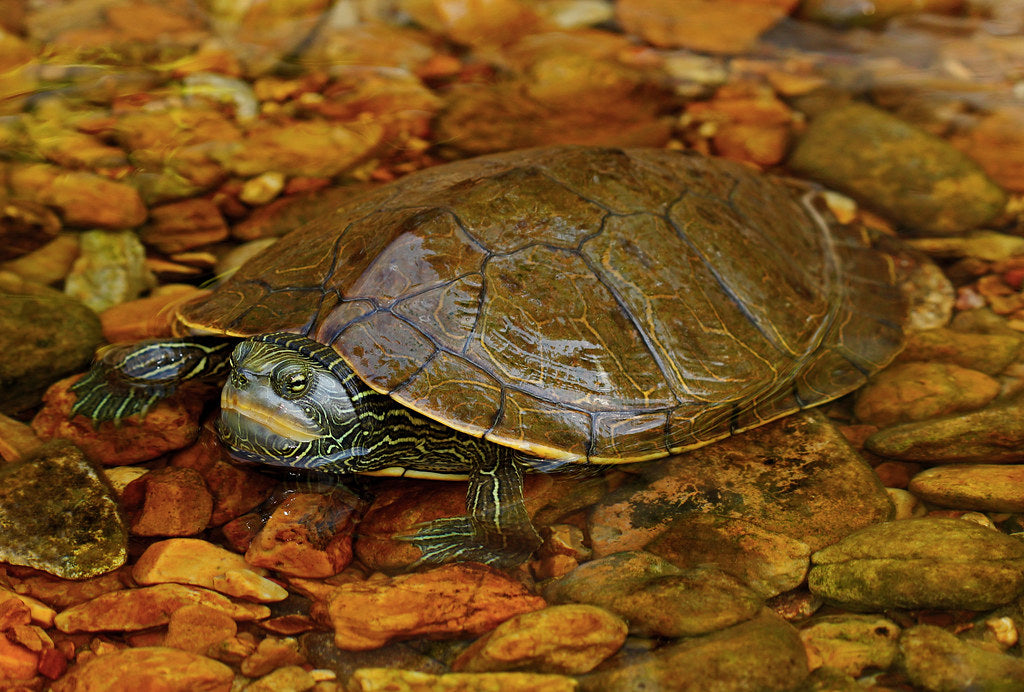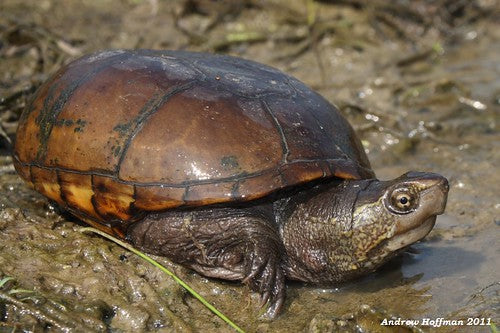The musk turtle (Sternotherus odoratus) is also known as the stinkpot turtle. They are a small, aquatic, nocturnal reptile with populations throughout the eastern United States. They naturally occur in the shallows of freshwater ponds, lakes, swamps, and other slow-flowing bodies of water with a soft bottom and plenty of vegetation.
Musk turtles have an average adult length of 4-5”, making them some of the smallest turtles in the pet trade. They have large heads, a pointed snout, round pupils, smooth domed shells, webbed toes, and an under-sized plastron. Coloring is generally black-brown with two thin yellow stripes on the head and neck.
Musk turtles make good beginner-level pet turtles because they’re generally hardy, and their small size makes them easy to house compared to most other species. With good care, they can live up to 50 years or so.
Note: Musk turtles may be native to the US, but that’s not a reason to take one from the wild if you want one as a pet. If you want a pet musk turtle, purchase one from a breeder or adopt one from a rescue or your local classifieds. Never take reptiles from the wild!
How much space do musk turtles need?
Musk turtles spend most of their time in water, so they do well when housed in an aquarium with a small basking area. The minimum for appropriately keeping one adult musk turtle is 40-50 gallons, or roughly 36”L x 18”W x 16”H. This is just the minimum, and providing a larger enclosure is both beneficial and appreciated!
That being said, if you have a female musk turtle, it’s a good idea to house her in a Waterland tub or similar instead of an aquarium, as she will need a readily-available area of land for routinely laying infertile eggs (similar to a chicken).
Water depth should be shallow enough to allow the turtle to breathe from the surface if it stands on its tiptoes from the bottom of the tank, although deeper can be used if you have underwater structures to bring the turtle closer to the surface.
Musk turtles tend to do well when housed outdoors where local climate permits, even if it’s just during part of the year. This is a convenient way to provide your turtle with a generously-sized pond and “free” heating and lighting. 100 gallon livestock tubs often work well for this purpose.
It’s best not to house multiple musk turtles in the same enclosure, as they can be aggressive toward other turtles in their “territory” — this is particularly true for males.
Do musk turtles need UVB?
Musk turtles require regular exposure to high-quality UVB in order to maintain optimal health and wellbeing. Providing UVB lighting to your turtle gives them all of the vitamin D that their body needs, stimulates better appetite and activity, and strengthens the immune system, as well as other benefits.
The best UVB bulbs for musk turtles are:
- Zoo Med Reptisun T5 HO 5.0
- Arcadia Forest 6%
The UVB bulb should be half the length of the enclosure and housed in a reflective fixture like the Arcadia ProT5 or Vivarium Electronics. Place the lamp close to the heat lamp. If it’s on top of a screen lid, the basking platform should be placed so the top of the turtle’s shell is 6-9” from the lamp. If there is no screen obstruction, the lamp should be placed so the top of the shell is 11-12” below.
UVB bulbs decay over time, so don’t forget to replace your bulb every 12 months to maintain good performance. If you are housing your turtle outdoors in an appropriate climate, supplementary lighting is not required.
Even though musk turtles are primarily nocturnal, it’s also a good idea to provide a strong LED or T5 HO 6500K daylight lamp for additional illumination. This helps better replicate daylight and is also good for any live plants you may be using. “Nighttime” lighting such as colored light bulbs should not be used.
Lights should be on for 14 hours/day during summer and 10 hours/day during winter, with gradual adjustments in-between.
What basking temperatures do musk turtles need?
Musk turtles are ectotherms, which means that they rely on the variable temperatures of their environment to help regulate their metabolism and stay healthy. Although musk turtles are known to be primarily aquatic, they still bask occasionally, so your setup needs to be mostly water with a small basking platform (for males) or a land area with loose sand/soil substrate (for females).
Temperature gradient:
- Basking area (air temp) — 90-95°F
- Water temp (juveniles) — 78-80°F
- Water temp (adults) — 72-78°F
Measure basking temperature with a digital probe thermometer, and water temperature with a high-quality aquarium thermometer.
A good way to warm the basking area is with a halogen flood heat lamp placed on one side of the enclosure and positioned over the basking area. Do not use ceramic heat emitters (CHEs), red bulbs, or blue bulbs, as these are not as effective. Increase the wattage if they’re too cool, and use a plug-in lamp dimmer if they’re too warm.
If you need to heat the water, use a high-quality aquarium heater rated for at least the maximum volume of water in the enclosure.
If you are housing your turtle outdoors, supplementary heating should not be required. However, if your area experiences a significant drop in temperature during winter, you will need to make sure your pond is equipped to allow your turtle to hibernate safely, or bring them inside once the weather starts to get colder.
How to maintain the water in a musk turtle aquarium?
Musk turtles prefer clean, clear water, which means that it must be kept clean at all times in order to keep your turtle healthy (and to keep the aquarium attractive). The most efficient way to do this is with a combination of excellent filtration and regular water changes.
Aquatic turtles are fairly messy creatures, so you will need a canister-style filter capable of handling at least 2-3x the amount of water in the enclosure. So, if you have an aquarium or pond with 40 gallons of water, you will need a filter rated for at least 80 gallons of water. Don’t settle for the cheapest filter you can find — this is one aspect of your turtle’s enclosure not to skimp on!
Use a low-flow aquarium filter designed for fish that prefer stagnant water, as musk turtles don’t like a strong current. If you can’t find something suitable, place a rock or similar directly under the filter’s output to disrupt the current.
Once every 1-2 weeks, remove and replace approximately 30% of the aquarium/pond’s total water volume. This helps minimize buildup of toxic compounds in the water that a filter is unable to resolve. To make the job easier, use a siphon or water pump.
Both indoor and outdoor turtle ponds require filtration and water changes.
What décor can you use in a musk turtle aquarium?
The most essential piece of “décor” you will need in your turtle’s enclosure is going to be a basking area. For females, this should be a partitioned-off area of land where the turtle can bask and deposit infertile eggs. For males, a small basking platform such as securely stacked rocks, a large piece of wood, or a commercially-available turtle basking platform can be used. The turtle should be able to easily climb onto the platform, and be able to remove its entire body from the water.
Aside from the basking area, there are additional ways you can increase the enclosure’s functionality and general attractiveness. Here are some ideas:
- live/artificial plants
- driftwood
- hollow logs
- terracotta pots
- fine-particle aquatic substrate (ex: sand)
Make sure your turtle has access to places where it can hide from view as needed.
What do musk turtles eat?
Musk turtles are omnivores, which means that they need to eat a balanced diet of both plant- and animal-based foods to get the nutrition that they need. However, most of their diet should be animal protein, especially when they’re hatchlings. Here is a general feeding schedule to follow:
Musk turtles <6 months old:
- protein food or pellets daily
Musk turtles >6 months old:
- protein food or pellets every other day
- vegetable food daily (for grazing)
Offer as much animal-based food as your turtle will eat in 5-10 minutes. A portion of chopped/shredded vegetables should be roughly the same size as the turtle’s shell. A portion of pellets should be roughly the same size as the turtle’s head. Beware of overfeeding — if your musk turtle starts to look chubby, reduce the amount of food offered at each feeding.
Animal-based foods for musk turtles: crickets, earthworms, dubia roaches, shrimp/krill, frozen bloodworms, silkworms, snails, grasshoppers, clams
Vegetable foods for musk turtles: spirulina algae wafers, duckweed, pond lily, eelgrass, water hyacinth, collard greens, dandelion greens, endive, green leaf lettuce, kale, red leaf lettuce, romaine lettuce
Pellets for musk turtles: Omega One Juvenile Turtle Pellets, Omega One Adult Turtle Sticks, Tetra ReptoMin, Zoo Med Natural Aquatic Turtle Food, Mazuri Aquatic Turtle Diet
Generally speaking, musk turtles prefer foods that sink to the bottom rather than floating foods.
Do musk turtles like to be handled?
As a general rule, turtles do not like to be handled, and musk turtles will often offer to bite when grabbed. True to their common name, they also secrete an orange-ish, foul-smelling musk as a deterrent when alarmed. It’s best to keep the handling to a minimum. Keep your fingers toward the rear of the carapace to avoid getting bitten.
If you would like to interact with your turtle, try hand-feeding it with a pair of feeding tongs.
*This care sheet contains only very basic information. Although it’s a good introduction, please do further research with high-quality sources to obtain additional information on caring for this species.
"Sternotherus odoratus * Sternotherus carinatus" by Laurent Lebois © is licensed under CC BY 2.0




Leave a comment
This site is protected by hCaptcha and the hCaptcha Privacy Policy and Terms of Service apply.